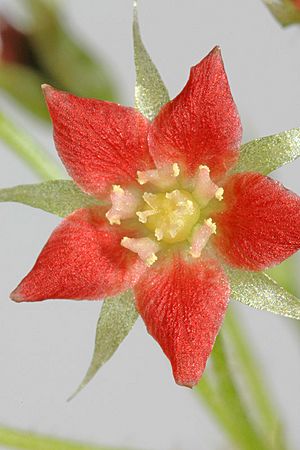Lance-leaved sundew facts for kids
Quick facts for kids Lance-leaved sundew |
|
|---|---|
 |
|
| Conservation status | |
|
Rare (NCA)
|
|
| Scientific classification | |
| Genus: |
Drosera
|
| Species: |
adelae
|
The lance-leaved sundew, also known as Drosera adelae, is a special carnivorous plant. It belongs to the Drosera family. This plant is found only in Queensland, Australia. This means it is endemic to that area.
Contents
About the Lance-Leaved Sundew
Drosera adelae is a tropical plant that lives for many years. We call plants like this perennial. It grows long, sword-shaped leaves that spread out from the base. This shape is called a rosette.
Like most other Drosera plants, its leaves are covered with sticky tentacles. These tentacles make a special glue. This glue helps the plant catch insects and other small prey. Unlike some other sundews, the tentacles on Drosera adelae move very slowly. You might barely notice them moving at all.
The leaves are narrow and shaped like a spear. They are usually about 10 to 25 centimeters (4 to 10 inches) long. They are also about 7 to 10 millimeters wide. The bottom of the leaves is smooth and hairless. The leaf stems are either very short or not there at all.
Flowers and Reproduction
Drosera adelae grows tall flower stalks, up to 35 centimeters (14 inches) long. These stalks have many flowers on one side. The flowers can be red, reddish-orange, or cream-colored. They bloom from June to November. Each flower has five petals that form a perfect five-sided shape.
This plant can make new plants very quickly without seeds. It does this by growing new plantlets from its roots. Because of this, you often find Drosera adelae growing in big groups.
Scientists have studied the plant's chromosomes. Most Drosera adelae plants have 30 chromosomes. However, some cultivated plants have been found with 28 chromosomes. This might mean there are different types of this species.
Where It Lives
Drosera adelae usually grows in shady spots in the rainforests of northeastern Australia. You can find it in sandy soil along creek banks. It also grows on wet rocks near waterfalls.
This plant is native to Rockingham Bay and Hinchinbrook Island in Queensland, Australia. It shares its home with two other close relatives. These are D. schizandra and D. prolifera. People sometimes call these three plants the "sisters of Queensland."
Plant History
The plant Drosera adelae was first officially described in 1864. This was done by a botanist named Ferdinand von Mueller. He wrote about it in his book called Fragmenta phytographiæ Australiæ.
Later, another botanist, Ludwig Diels, described a different form of the plant in 1909. He called it D. adelae var. latior. But now, scientists believe this form is actually the same as D. schizandra.
Growing This Plant
Even though D. adelae is a tropical plant, it can handle a little bit of cold. It can even grow back from its roots after short times when the temperature drops below freezing.
You can grow this plant in brighter light, less humidity, and cooler temperatures. This is different from its close relatives, D. prolifera and D. schizandra. If the plant doesn't get much light, its leaves will be greener. It can also grow to be about 30 centimeters (a foot) wide. But if it gets brighter light, the leaves will be shorter and have a bronze color.
See also
 In Spanish: Drosera adelae para niños
In Spanish: Drosera adelae para niños




